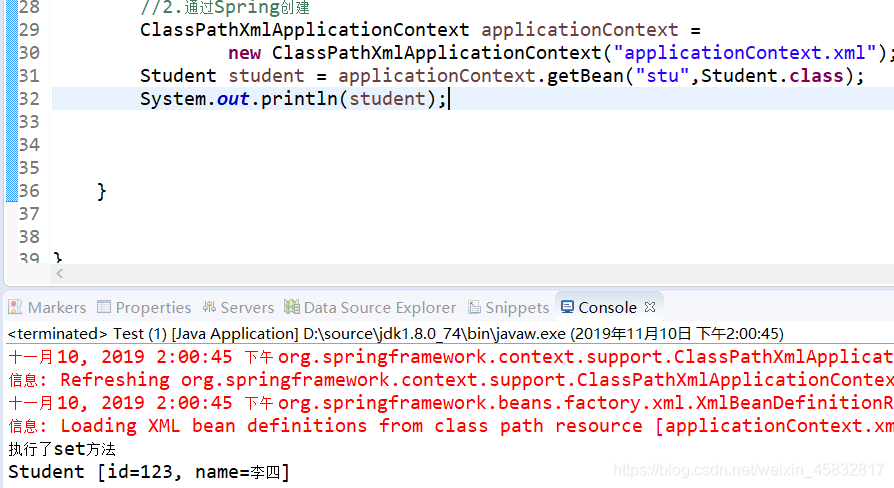- ubuntu12.04环境下使用kvm ioctl接口实现最简单的虚拟机
- Ubuntu 通过无线网络安装Ubuntu Server启动系统后连接无线网络的方法
- 在Ubuntu上搭建网桥的方法
- ubuntu 虚拟机上网方式及相关配置详解
CFSDN坚持开源创造价值,我们致力于搭建一个资源共享平台,让每一个IT人在这里找到属于你的精彩世界.
这篇CFSDN的博客文章Spring中如何使用@Value注解实现给Bean属性赋值由作者收集整理,如果你对这篇文章有兴趣,记得点赞哟.
。
只用Spring注解开发的时候,可以使用@Value搭配@PropertySource注解进行给Bean的属性进行赋值.
@Value 。
。
@Target({ElementType.FIELD, ElementType.METHOD, ElementType.PARAMETER, ElementType.ANNOTATION_TYPE})@Retention(RetentionPolicy.RUNTIME)@Documentedpublic @interface Value { /** * The actual value expression: for example {@code #{systemProperties.myProp}}. */ String value();}
可以看到@Value注解接受的参数只能是字符串,所以使用时参数都需要带上双引号。并且可以在属性,方法,参数等位置上标注。value属性支持以下三种类型:
基本数据类型,包括String,int,boolean等类型.
SpEL,#{}的形式即表示使用SpEL表达式,一般用于获取环境中其他bean的属性,当使用Elivis运算符“表达式1?:表达式2”,比如#{ “obj.property? :default_value” }形式时,这里的obj是取当前容器中的对象,default_value就是前面的值为空时的默认值.
在主配置类中通过@PropertySource注解加载配置文件,然后通过${ property : default_value}的形式取配置文件中的值,其中default_value表示前面的值为空时的默认值.
。
。
以下两个实体类Student类和Teacher类 。
public class Teacher { public int id; public String name; public Teacher() { // TODO Auto-generated constructor stub System.out.println("teacher-----创建"); } public Teacher(int id, String name) { super(); this.id = id; this.name = name; } //省略getter和setter方法}
在Student类中使用${}取配置文件的值,#{}取容器中的teacher对象的name属性 。
public class Student{ @Value("1") private int id; @Value("${student.name}") private String name; @Value("${student.address:北京}") private String address; @Value("#{teacher.name?:"老子"}") private String teacherName; @Override public String toString() { return "Student [id=" + id + ", name=" + name + ", address=" + address + ", teacherName=" + teacherName + "]"; }//省略getter和setter方法}
。
添加以下值:
student.name=张三person.address=广州市
。
使用@PropertySource注解读取外部配置文件person.properties中的key/value保存到运行的环境变量中.
@Configuration@PropertySource("person.properties")public class SpringConfig2 { @Bean public Student student() { return new Student(); } @Bean public Teacher teacher() { return new Teacher(2,"老李"); }}
。
编写代码获取容器中的id为student的bean和直接获取配置环境的属性值.
public class IoCTest { @Test public void test() { //获取Spring的IOC容器 AnnotationConfigApplicationContext applicationContext=new AnnotationConfigApplicationContext(SpringConfig2.class); //从容器中获取bean Student stu = (Student) applicationContext.getBean("student"); System.out.println(stu); //获取环境变量 ConfigurableEnvironment environment = applicationContext.getEnvironment(); String property = environment.getProperty("person.address"); System.out.println(property); //关闭容器 applicationContext.close(); }}
。

。
。
。
通过property标签(内部是通过调用类的set方法将值注入) 。


以上为个人经验,希望能给大家一个参考,也希望大家多多支持我.
原文链接:https://blog.csdn.net/huangjhai/article/details/104807041 。
最后此篇关于Spring中如何使用@Value注解实现给Bean属性赋值的文章就讲到这里了,如果你想了解更多关于Spring中如何使用@Value注解实现给Bean属性赋值的内容请搜索CFSDN的文章或继续浏览相关文章,希望大家以后支持我的博客! 。
我在网上搜索但没有找到任何合适的文章解释如何使用 javascript 使用 WCF 服务,尤其是 WebScriptEndpoint。 任何人都可以对此给出任何指导吗? 谢谢 最佳答案 这是一篇关于
我正在编写一个将运行 Linux 命令的 C 程序,例如: cat/etc/passwd | grep 列表 |剪切-c 1-5 我没有任何结果 *这里 parent 等待第一个 child (chi
所以我正在尝试处理文件上传,然后将该文件作为二进制文件存储到数据库中。在我存储它之后,我尝试在给定的 URL 上提供文件。我似乎找不到适合这里的方法。我需要使用数据库,因为我使用 Google 应用引
我正在尝试制作一个宏,将下面的公式添加到单元格中,然后将其拖到整个列中并在 H 列中复制相同的公式 我想在 F 和 H 列中输入公式的数据 Range("F1").formula = "=IF(ISE
问题类似于this one ,但我想使用 OperatorPrecedenceParser 解析带有函数应用程序的表达式在 FParsec . 这是我的 AST: type Expression =
我想通过使用 sequelize 和 node.js 将这个查询更改为代码取决于在哪里 select COUNT(gender) as genderCount from customers where
我正在使用GNU bash,版本5.0.3(1)-发行版(x86_64-pc-linux-gnu),我想知道为什么简单的赋值语句会出现语法错误: #/bin/bash var1=/tmp
这里,为什么我的代码在 IE 中不起作用。我的代码适用于所有浏览器。没有问题。但是当我在 IE 上运行我的项目时,它发现错误。 而且我的 jquery 类和 insertadjacentHTMl 也不
我正在尝试更改标签的innerHTML。我无权访问该表单,因此无法编辑 HTML。标签具有的唯一标识符是“for”属性。 这是输入和标签的结构:
我有一个页面,我可以在其中返回用户帖子,可以使用一些 jquery 代码对这些帖子进行即时评论,在发布新评论后,我在帖子下插入新评论以及删除 按钮。问题是 Delete 按钮在新插入的元素上不起作用,
我有一个大约有 20 列的“管道分隔”文件。我只想使用 sha1sum 散列第一列,它是一个数字,如帐号,并按原样返回其余列。 使用 awk 或 sed 执行此操作的最佳方法是什么? Accounti
我需要将以下内容插入到我的表中...我的用户表有五列 id、用户名、密码、名称、条目。 (我还没有提交任何东西到条目中,我稍后会使用 php 来做)但由于某种原因我不断收到这个错误:#1054 - U
所以我试图有一个输入字段,我可以在其中输入任何字符,但然后将输入的值小写,删除任何非字母数字字符,留下“。”而不是空格。 例如,如果我输入: 地球的 70% 是水,-!*#$^^ & 30% 土地 输
我正在尝试做一些我认为非常简单的事情,但出于某种原因我没有得到想要的结果?我是 javascript 的新手,但对 java 有经验,所以我相信我没有使用某种正确的规则。 这是一个获取输入值、检查选择
我想使用 angularjs 从 mysql 数据库加载数据。 这就是应用程序的工作原理;用户登录,他们的用户名存储在 cookie 中。该用户名显示在主页上 我想获取这个值并通过 angularjs
我正在使用 autoLayout,我想在 UITableViewCell 上放置一个 UIlabel,它应该始终位于单元格的右侧和右侧的中心。 这就是我想要实现的目标 所以在这里你可以看到我正在谈论的
我需要与 MySql 等效的 elasticsearch 查询。我的 sql 查询: SELECT DISTINCT t.product_id AS id FROM tbl_sup_price t
我正在实现代码以使用 JSON。 func setup() { if let flickrURL = NSURL(string: "https://api.flickr.com/
我尝试使用for循环声明变量,然后测试cols和rols是否相同。如果是,它将运行递归函数。但是,我在 javascript 中执行 do 时遇到问题。有人可以帮忙吗? 现在,在比较 col.1 和
我举了一个我正在处理的问题的简短示例。 HTML代码: 1 2 3 CSS 代码: .BB a:hover{ color: #000; } .BB > li:after {

我是一名优秀的程序员,十分优秀!